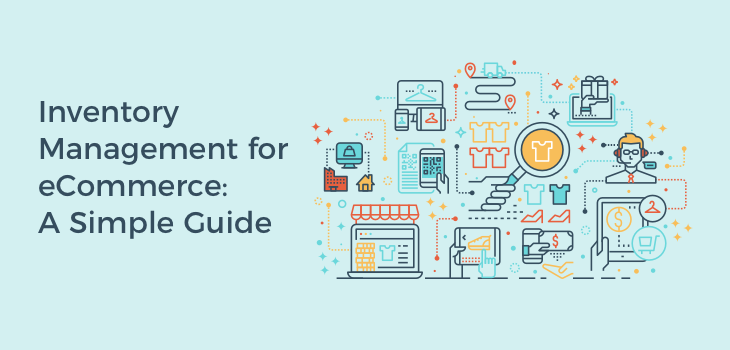
Building a sustainable eCommerce business in today’s modern era is almost completely reliant on proper inventory management. No matter the size of your business, managing your inventory effectively plays a huge part in your success. Poor inventory management can lead to poor customer relationships and loss of revenue, and it can be hard to recover from this irrespective of your level of expertise, the type of products you sell, or the size of your business. Since inventory management is so important, it only makes sense that all business owners, managers, and entrepreneurs should learn the best tips, secrets, and ins and outs of inventory management for eCommerce.

Why Inventory Management Should Be a Top Priority
Inventory management is the process of overseeing the volume, diversity, pricing, and location of your products. When a product is in stock, it is part of your business’ inventory and is managed as moves through the supply chain, or from you to your customer. Since inventory management is all about keeping track of your products from start till the end. For example, if you do not have the right numbers for a certain product or if a product is out of stock and listed incorrectly in your records, it could lead to a poor customer experience. They may receive the wrong product, have a long wait to receive the right product, or get tangled up waiting to cancel their order altogether. When the inventory is managed well and effectively, customers are happy, business booms, and you can foresee growth.
Your Simple Guide to Inventory Management for eCommerce

To really get a handle on inventory management for eCommerce, check out this simple guide. It contains everything you need to know.
Terms to Familiarize Yourself With
- Inventory: Inventory refers to all tangible items, good, and products to be sold to customers.
- Supply Chain: The supply chain refers to the processes and systems responsible for producing, managing, and distributing a product/piece of inventory.
- Units of Measure: The way you measure your stock – this could be items, bundles, pieces, ounces, kilograms, etc.
- SKUs: This refers to a stock keeping unit – an identification code used to classify and organize your products.
- Minimum Viable Stock: This is the minimum amount of a product you need to have on-hand to keep up with consumer demand.
- Variants: This refers to variations of the same product such as a toaster that comes in different colors or finishes.
- Dead Stock: Deadstock is inventory you have in stock but may not be able to sell anymore.
- FIFO: FIFO refers to “First In First Out” and is described as an accounting method that identifies sellable assets such as raw materials, inventory, and other items or components that were received first and then sold first. In other words, the oldest inventory is sold first.
- ABC Analysis: This is a method of prioritizing the inventory you already have using three categories:
- High-value products with low-frequency sales
- Moderate value products with a moderate frequency of sales
- Low-value products with a high frequency of sales
- Dropshipping: This is a fulfillment method in which inventory is not actually stored onsite. Instead, all inventory is shipped from a third party to the customer directly.
- COGS: COGS, or the Cost of Goods Sold, is described as an accounting term that is reported on the income statement that details the total cost of the products/items sold by a business and considered an expense.
- JIT: JIT, or Just-in-time, is another fulfillment method in which inventory orders are made “just in time” to keep up with the demand of your customers. This method is good for keeping inventory flowing without getting money tangled up with unsold inventory.
- Inventory Forecasting: This refers to making an informed decision about ordering and reordering certain products based on their historical data, seasonality, and market trends.
- Inventory Management Software: Inventory management software are tools that aid you in tracking inventory, streamlining processes, automating tasks like data entry, leveraging data, and other insights to help business management to be smooth and successful.
Common Issues You’ll Face
The following are some of the most common issues and problems you’ll face when finding your balance of inventory management.
- Overstocking and Understocking: When inventory is overstocked, it can cost you money in storage fees, tying up resources and slowing down your workflow. Similarly, if you are understocked, you risk losing sales due to not having enough items in stock to meet demand.
- Lost Stock: Lost stock refers to a situation when your computer or management system suggests that you have a certain amount of items in stock when in reality you have less. For example, it may say you have three of a certain blouse in stock when you actually have one. This lost stock can lead to canceled or back orders which can affect customer satisfaction, your business reputation, and ultimately cost you money.
- Human Error: One of the biggest issues with inventory management is human error. When working without inventory management software, employees have to manually manage some tedious processes. These will include data entry, reordering stock, sending out shipping information, and other tasks that can be automated. Without a system, employees may use spreadsheet to keep track of data which can get lost, damaged, ruined, or otherwise compromised. In short, human error is natural but can be detrimental to your eCommerce business.
While each of these issues is troublesome, they can all be fixed by moving from manual data entry, retention, and to an inventory management software system.
Inventory Management Systems and Software
Inventory management for eCommerce or a centralized system is important for keeping track of your business inventory in one location. Inventory management software can ensure that you don’t undersell or oversell products, allows you to integrate all your tools.
A CMMS software can further enhance these processes by providing predictive maintenance and automated workflows, ensuring that your operations run smoothly and efficiently. Inventory management systems are cloud-based and come with a number of useful features accessibility.
Inventory management systems are cloud-based and come with a number of useful features accessibility. By implementing a reliable inventory system, businesses can streamline operations and optimize their inventory management processes.
Companies often turn to supply chain consulting to further enhance these processes and ensure efficient integration.
Some useful features included with inventory management software include:
- Auto-Updated Marketplaces and Shopping Carts: The software can immediately include the supplier quantity in your online selling channels to reflect more accurate levels of inventory.
- Restock Forecasting: As your business grows, so does consumer demand. This means you have a lot to keep up with as you experience growth and gain new customers. Inventory management software can help forecast when you need to restock and how much you need to restock to ensure your business is always up to date with customer demand. The software automatically calculates dynamic reorder points based on your inputs so that everything runs smoothly.
- Multichannel Marketplace Support: If you operate your business from multiple channels and marketplaces, you want software that will keep everything connected. This is especially useful for eCommerce businesses as they have a lot of online channels to keep track of. Inventory makerspace management software can keep track of everything with accurate updates and allows accessibility from all mobiles, tablets, and computers. Moreover, it provides the necessary digital documentation solution, which can save digital documents with automatic naming and archiving based on the document profile. Software supports the most common export formats, including TIFF, PNG, JPG, BMP, and PDF. Therefore, you don’t have to worry about how you’ll open your document from a different device.
- Barcode Scanning: Barcode and scanning solutions improve accuracy in the warehouse and throughout the supply chain. Barcodes help each an every item in your inventory stay accounted for from the smart warehouse to the customer. This can also expand to lots and serial numbers to keep track of stock takes transfers, and batches of inventory. Barcode software and scanners improve traceability of items and overall accuracy in inventory management.
We hope this simple guide provides the information you need to really transform how you handle inventory management for eCommerce.

Leave a Reply
You must be logged in to post a comment.